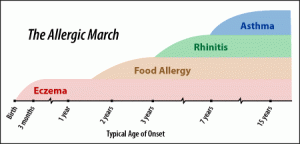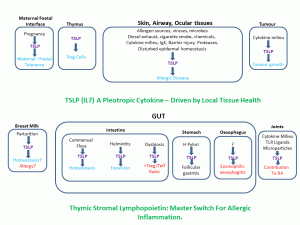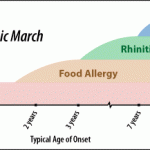
Many Nutritional Therapists will consult people with a well-defined allergy or in some cases a range of symptoms that reflect an allergic response that do not meet the recognised IgE diagnosis. Some of these people will also be experiencing what is known as the ‘allergic march’ – the development of secondary allergenic profiles such as asthma after already having an established food allergy, such as peanut or shellfish.
The allergic march usually begins with eczema – a dry, red, scaly rash that causes considerable itching and discomfort. Eczema is most commonly diagnosed within the first few months of life. In 1/3 to 1/2 of children, eczema is associated with an underlying food allergy. Food allergies (peanut allergy, for instance) generally begin to appear within the first three years of a child’s life. Food allergy can cause gastrointestinal problems (such as colic, diarrhoea, etc.) and in some cases, it can be life threatening. As children age further, the allergic march may proceed to the development of asthma and/or rhino-conjunctivitis (sometimes called hayfever).
The pattern of development of allergic diseases – what types of disease occurs and the age at which they occur is highly reproducible (i.e. the pattern is the same in a large proportion of children and increasingly in adults as well).
Allergy is the result of a complex immune cascade leading to the dysregulated production of Th2 cytokines, the generation of allergen-specific IgE-producing B cells and the subsequent activation and degranulation of mast cells upon allergen challenge.
TSLP (Thymic Stromal Lymphopoietin)
One of the principle cells known to play very important roles in the development and resolution of allergy and other complications related to adverse immune responses in the mucosal and epithelial tissues are dendritic cells (DC’s). These cells when brought into contact with TSLP favour the allergenic profile – that is they convert naïve T cells into Th2 cells and amplify allergy risk and symptoms.[1] DCs are the professional antigen presenting cells that have the capability to sense invaded pathogens and tissue stress, then present antigen to T cells, thereby bridging the innate and adaptive immunity.

What this mechanism has helped to us to understand is that local tissues, in this case the epithelial tissues themselves, have the capacity to influence immune responses that in turn drive adaptive immune outcomes. This indicates that altered barrier quality and local inflammation may be a cause or at least an amplifier of allergenic inflammation via TSLP promotion.[2] Recent studies have revealed that various cell types other than epithelial cells and epidermal keratinocytes (such as mast cells, airway smooth muscle cells, fibroblasts, dendritic cells, trophoblasts, and cancer or cancer-associated cells) also express TSLP.[3]
Environmental factors such as Toll-like receptor ligands, a Nod2 ligand (innate immune signalling proteins), viruses, microbes (dysbiosis), allergen sources, helminths, diesel exhaust, cigarette smoke, and chemicals trigger TSLP production as well.
Compelling evidence implicates TSLP as playing a pivotal role in the pathobiology of allergic asthma and atopic dermatitis.[4] Other studies suggest it may have an amplifying effect in food allergy and inflammatory bowel disease.[5] These cross reactions suggest a critical role for TSLP as a driving factor in the emerging concept of tissue-specific control of immunity with TSLP secretion at the epithelial-DC interface acting as an initial and amplifying factor in the pro-allergic cascade also known as the allergic march.[6]
What can we do
 Apart from the interesting relationships between tissue health and immune reactivity, postulated some time ago by Polly Matzinger and colleagues.[7] The clinical question is can we moderate inappropriate TSLP production and when and how should we do it? Is TSLP only problematic or can it confer benefit and does its role extend beyond the allergenic profile?
Apart from the interesting relationships between tissue health and immune reactivity, postulated some time ago by Polly Matzinger and colleagues.[7] The clinical question is can we moderate inappropriate TSLP production and when and how should we do it? Is TSLP only problematic or can it confer benefit and does its role extend beyond the allergenic profile?
TSLP is capable of inducing tolerance, during maternal foetal tolerance requirements, especially during early pregnancy. TSLP promotes Th2 and Treg cells required for a successful pregnancy.[8] TSLP may induce thymically originating regulatory T cells, by being expressed by the epithelial cells present in the thymic tissue. Centrally produced Treg cells have similar roles to those produced in the periphery – most commonly in the gut, but are still important players in maintaining human tolerance.[9]
Certain cancer cells, however, seem to proliferate more easily when exposed to TSLP. The cancer-promoting activity of TSLP primarily required signalling through the TSLP receptor on CD4(+) T cells, promoting Th2-skewed immune responses and production of immunosuppressive factors such as IL-10 and IL-13 so permitting cancer cells to avoid destruction.[10],[11]
Our stomachs may also be the worse off post infection by H.Pylori through the induction of TSLP, as the altered T cell phenotype towards the Th2 cell presentation favours chronic and follicular gastritis.[12]
Natural Manipulation of TSLP
TSLP inhibition has been studied using three natural agents to determine their effectiveness in down regulating its output. The mineral selenium (Se) has various effects such as antioxidant, anti-tumour, anti-ulcer, and anti-inflammatory effects. One paper suggests it can impact in a significant manner on the mast cell promotion of TSLP indicating its potential use for inflammatory and allergenic illness.[13]
The same researchers have also identified the benefit can be repeated through the use of berberine and green tea extracts along with grapefruit juice.[14],[15],[16]
Other researchers have looked at the role of cis retinoic acid as a TSLP inhibitor via its action of the nuclear inflammation promoter NFkB and through the binding to the family of retinoic acid receptors (RAR) and the retinoid X receptors (RXR).[17]
The correction of any relevant dysbiosis, repair of barrier integrity and modification of diet selection to favour antioxidant rich foods will also be part of the programme to modify TSLP as it is driven in large part by the health of the local tissues.
The use of probiotics to increase IL-10 and TGF-Beta will also favour a T cell phenotype that regulates imbalances between Th2 and Th1 helper T cells.
Conclusion
TSLP is an interesting molecule that may represent a therapeutic target. We are unable to measure this cytokine for clinical purposes, but the strategy to apply for people with allergies, beyond the exclusionary principle of triggering foods or environmental exposure, permits us to approach the prevention or resolution with a key mechanism in mind.
Early days yet, but as more studies are done I expect a number of foods and food substrates will demonstrate benefit and may well reflect the genetic requirement for food selection.
References
[1] Soumelis V, Liu YJ. Human thymic stromal lymphopoietin: a novel epithelial cell-derived cytokine and a potential key player in the induction of allergic inflammation. Springer Semin Immunopathol. 2004 Feb;25(3-4):325-33. Epub 2003 Nov 29. Review. View Abstract
[2] Wang YH, Liu YJ. Thymic stromal lymphopoietin, OX40-ligand, and interleukin-25 in allergic responses. Clin Exp Allergy. 2009 Jun;39(6):798-806. Epub 2009 Apr 7. Review. View Full Paper
[3] Takai T. TSLP expression: cellular sources, triggers, and regulatory mechanisms. Allergol Int. 2012 Mar; 61(1):3-17. Epub 2012 Jan 25. View Full Paper
[4] Huston DP, Liu YJ. Thymic stromal lymphopoietin:a potential therapeutic target for allergy and asthma. Curr Allergy Asthma Rep. 2006 Sep;6(5):372-6. Review. View Abstract
[5] Blázquez AB, Mayer L, Berin MC. Thymic stromal lymphopoietin is required for gastrointestinal allergy but not oral tolerance. Gastroenterology. 2010 Oct;139(4):1301-9. Epub 2010 Jun 23. View Abstract
[6] Edwards MJ. Therapy directed against thymic stromal lymphopoietin. Drug News Perspect. 2008 Jul-Aug;21(6):312-6. Review. View Abstract
[7] Matzinger P, Kamala T. Tissue-based class control: the other side of tolerance. Nat Rev Immunol. 2011 Mar;11(3):221-30. View Abstract
[8] Li DJ, Guo PF. The regulatory role of thymic stromal lymphopoietin (TSLP) in maternal-fetal immune tolerance during early human pregnancy. J Reprod Immunol. 2009 Dec;83(1-2):106-8. Epub 2009 Oct 25. View Abstract
[9] Hanabuchi S, Ito T, Park WR, Watanabe N, Shaw JL, Roman E, Arima K, Wang YH, Voo KS, Cao W, Liu YJ. Thymic stromal lymphopoietin-activated plasmacytoid dendritic cells induce the generation of FOXP3+ regulatory T cells in human thymus. J Immunol. 2010 Mar 15;184(6):2999-3007. Epub 2010 Feb 19. View Abstract
[10] Olkhanud PB, Rochman Y, Bodogai M, Malchinkhuu E, Wejksza K, Xu M, Gress RE, Hesdorffer C, Leonard WJ, Biragyn A. Thymic stromal lymphopoietin is a key mediator of breast cancer progression. J Immunol. 2011 May 15;186(10):5656-62. Epub 2011 Apr 13. View Abstract
[11] Pedroza-Gonzalez A, Xu K, Wu TC, Aspord C, Tindle S, Marches F, Gallegos M, Burton EC, Savino D, Hori T, Tanaka Y, Zurawski S, Zurawski G, Bover L, Liu YJ, Banchereau J, Palucka AK. Thymic stromal lymphopoietin fosters human breast tumor growth by promoting type 2 inflammation. J Exp Med. 2011 Mar 14;208(3):479-90. Epub 2011 Feb 21. View Abstract
[12] Helicobacter pylori promotes the production of thymic stromal lymphopoietin by gastric epithelial cells and induces dendritic cell-mediated inflammatory Th2 responses. Kido M, Tanaka J, Aoki N, Iwamoto S, Nishiura H, Chiba T, Watanabe N. Infect Immun. 2010 Jan;78(1):108-14. Epub 2009 Oct 19. View Abstract
[13] Moon PD, Kim HM. The suppression of thymic stromal lymphopoietin expression by selenium. Amino Acids. 2011 Nov 16. View Abstract
[14] Moon PD, Choi IH, Kim HM. Berberine inhibits the production of thymic stromal lymphopoietin by the blockade of caspase-1/NF-κB pathway in mast cells. Int Immunopharmacol. 2011 Nov;11(11):1954-9. Epub 2011 Aug 19. View Abstract
[15] Moon PD, Choi IH, Kim HM. Epigallocatechin-3-O-gallate inhibits the production of thymic stromal lymphopoietin by the blockade of caspase-1/NF-κB pathway in mast cells. Amino Acids. 2011 Aug 11. View Abstract
[16] Moon PD, Choi IH, Kim HM. Naringenin suppresses the production of thymic stromal lymphopoietin through the blockade of RIP2 and caspase-1 signal cascade in mast cells. Eur J Pharmacol. 2011 Dec 5;671(1-3):128-32. Epub 2011 Sep 24. View Abstract
[17] Lee HC, Headley MB, Iseki M, Ikuta K, Ziegler SF. Cutting edge: Inhibition of NF-kappaB-mediated TSLP expression by retinoid X receptor. J Immunol. 2008 Oct 15;181(8):5189-93. View Abstract





